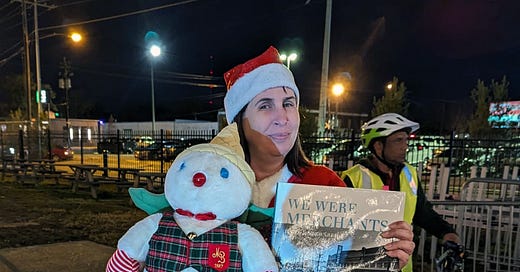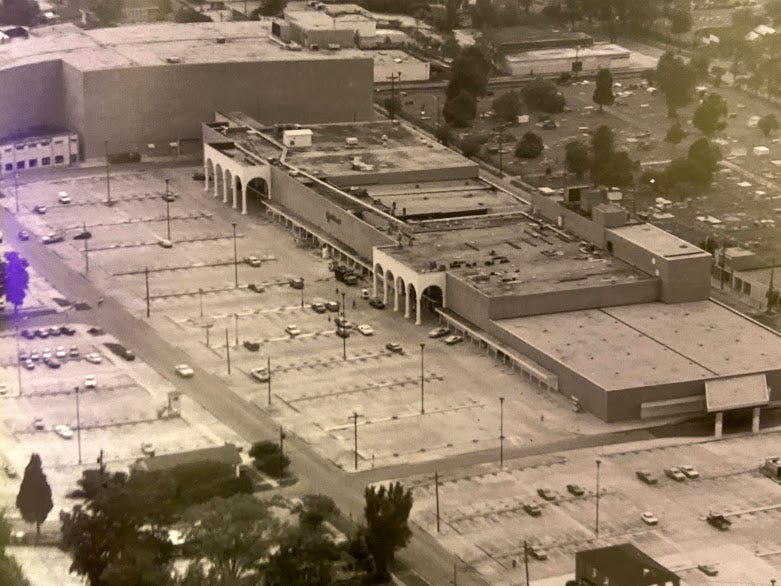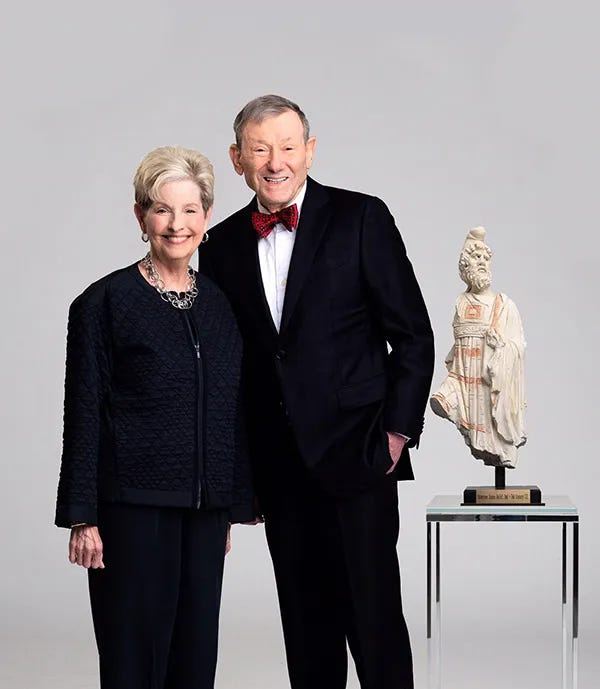Remembering Goudchaux on our final 2023 ride
For our final ride of 2023, we took along the Mr. Bingle. The stuffed toy was purchased for me by my sister back in 1987 when she was an employee at Goudchaux. The once iconic department store was so well-known for its Christmas display I thought it only appropriate to give it a nod as we set out for our final ride before our holiday break.
The Goudchaux Christmas tradition started in the early 1950s. The massive Santa Claus exhibition began after Thanksgiving at its Main Street store.
“A helicopter flew a ‘live’ costumed Santa to the parking lot each year, offering a friendly knee for every child,” states Hans Sternberg in his book We Were Merchants. “Pictures with that Santa cost only one dollar originally, and the waiting line could get quite long. But it was the animated, laughing, mechanical Santa that caught the attention of our customers.”
Going to the Goudchaux Santa display was a travel worthy event. While Goudchaux’s was known for its Santa, Maison Blanche in New Orleans had Mr. Bingle. It was a Christmas puppet dressed as a snowman, wearing an inverted ice-cream cone hat and carrying a striped candy cane.
The Mr. Bingle jingle was:
Jingle, Jangle, Jingle, here comes Mr. Bingle
With another message from Kris Kringle.
Time to launch the Chrismas Season,
Maison Blanche makes Christmas pleasin’.
Gifts galore for you to see
Each a gem from…MB.
When Goudchaux purchased Maison Blanche, they began selling the Mr. Bingle stuffed-toy replicas in all their stores. If you want to read the full story, you should pick up the fabulous book. Or, if you’re nice, I’m happy to lend you my copy.
A Bit More Goudchaux History
The store was founded in 1907 in the 1700 block of Main Street by brothers Bernard and Jake Goudchaux. Their parents immigrated to Bunkie, Louisiana from France. The boys left Bunkie and settled in Baton Rouge.
In its beginning, the store was 6,000-square feet and had three employees. It was located on a dirt road with a cemetery as its neighbor. It was on the “outskirts of town,” not far from the infamous restricted district.
The true shopping district of the city was located on Third Street in the heart of downtown proper. Main Street, although part of the shopping destinations, reached to the furthest point of the city boundary, and that’s exactly where Goudchaux was located.
Over the next two decades, Baton Rouge was booming! By 1925 the store outgrew its modest beginning and moved to a larger location a couple blocks down the road to 1500 Main Street. It grew to 10,000-square-feet.
Jake Goudchaux died in 1933, leaving Bernard, or Bernie as he was known around town, to continue managing the store.
After his brother’s death, Bernie began thinking about retirement. His son, Harry, didn’t have an interest in taking over the family business. In fact, rumor has it the two didn’t get along so well because Harry was a bit of a party boy. Happens to the best of us, I suppose.
A few years after his brother’s death, Bernie had a meeting with a young man named Erich Sternberg, who had only been in the country a few months.
And this is where our story becomes less about the man who founded the store and more about the family that made the store firmly rooted as an icon.
Meet The Sternbergs
Erich Sternberg was born on August 18, 1901 in Aurich, Germany. He married Lea Knurr. Both were Orthodox Jews, a congregation that maintained roughly 7 percent of the population of Aurich at the time.
The couple’s first child, Josef, came along in 1928. Next came Insa in 1930. Finally, baby Hans was born in 1935.
A couple months after Hans was born, the Nuremberg Laws were enacted. The laws excluded Jewish people from citizenship and was the beginning of what would become one of the greatest human tragedies of all time.
At this time, the Sternberg family realized they had to get out of Germany, but the task would prove difficult.
Fleeing Germany
To get anywhere, you need money. But thanks to the Nazi regime, getting money out of the country became nearly impossible. So, Erich was forced to smuggle roughly $24,000 out of the country. By today’s standards, that’s roughly $450,000.
“These funds would be used to get to America and establish a business there, and Erich’s parents would help my mother and the children while he was gone,” Hans said. “Legally, he could not take that much money out of the country, so he had to devise a way to smuggle it out of Germany. He would need the cash at the ready when he reached the United States. It was a highly perilous game.”
He attempted several different methods and eventually got the money out. Erich took the journey without Lea. She and the children stayed behind while Erich got to America and established a base camp in Baton Rouge, Louisiana.
How the heck did he end up there?
First, he went to the place where most immigrant stories begin - New York. Off the boat he went to Philadelphia, then Jackson, Mississippi, then New Orleans. It was in New Orleans when he was given a tip about a business in Baton Rouge that could be available for purchase. So, off he went to inspect the Goudchaux business.
“The Main Street store was a dozen blocks east of the more prestigious downtown shopping district and bustling Mississippi River wharf,” Hans wrote. “Even worse, in Erich’s eyes, was the fact that dead-end streets bordered the store on three sides. A cemetery completed the uninviting perimeter. (Adjacent railroad tracks didn’t help the neighborhood, either.)”
Erich couldn’t see the value of this business so he left without stepping one foot in the building. He told his friend, “I cannot make a living selling clothes to dead people.”
He did, however, take a position at the store. He worked the floor in the Men’s department and learned the structure of the business. After six weeks, he decided to lease the men’s department.
Once this agreement was made, Erich decided it was time for the rest of the family to come. He sent a coded message to Lea. It said, “Today waited on 1st customer stop.”
Hans said his mother would often tell him, “Had I known how bad it was going to get in your father’s absence, I would have taken you and left with him.”
Thankfully, they got out in time. According to Hans, 59 relatives did not make it out of Germany. They were among the 6 million who perished during the Holocaust.
Erich helped roughly 100 relatives and friends escape from Germany. In 1985, Erich posthumously received an international award from B’nai B’rith for his humanitarian efforts.
Welcome to Baton Rouge!
The next several years were good to the Sternbergs and Baton Rouge played host very well to this family that made its way out of hell. With their partial investment in the business, they managed to purchase a lot in the Garden District. They paid $2,000. A couple years later, they bought the adjacent lot and house for $10,800.
Now nestled firmly in the city’s social hierarchy, the Steinberg family got its official welcome packet of citizenship on April 16, 1942.
In 1945, Erich and Lea took the plunge and purchased the Goudchaux business in its entirety. At the time, they had 23 employees. By the time of the final year of business, the company employed 8,800 people and brought in about $480 million a year.
The growth of the company to become a corporation was only made possible by the interpersonal way the family conducted business. This was a place that made you feel like you were part of the family. In fact, Erich often said, “If your store doesn’t possess a family atmosphere, you might as well be Sears.”
Erich had a lot of strong opinions, and so did Lea. Both seemed firm in their convictions, and both seemed beloved by the community.
So what makes a place have a family atmosphere?
Being part of the community seems to be key. All of their marketing campaigns focused on that principle. The way to the heart of a parent is through their kid, and kids loved Goudchaux.
A Coke would cost you .5 cents. Erich kept a stash of nickels in his pocket and would give them to kids as they would come in the door. They eventually started giving out a nickel for every A on a report card.
Ah, now you’re getting it.
But what about mom and dad? Why should they shop there?
INTEREST-FREE CREDIT.
People were loyal to Goudchaux for giving them a way to keep things going, even when times were tough.
Profits were rising, so the store started expanding. After 10 expansions, the store grew to be 130,000 square feet. But the expansions didn’t stop there. They continued and by 1986, the building made its way into the Guinness Book of World Records for being the longest building in the world devoted to a department store.
Boys to (Company) Men
After a long career, Erich officially retired as the president, but stayed on as chairman of the board. The boys were now in charge of the place.
Joseph took on the title of president and Hans was the executive vice president and treasurer. Little did they know that Erich’s retirement wouldn’t last long. He died one year later at the age of 63.
The next decade is when things start to get really interesting. Goudchaux expanded by adding locations in Baton Rouge, then Lafayette, and the next stop was New Orleans.
The Marriage of Goudchaux and Maison Blanche
New Orleans already had its own immigrant-started department store with local charm. Maison Blanche was founded by Isidore Newman in 1892. The first store was located on Canal and Dauphine Street in downtown New Orleans.
In 1909, Newman tore down the original store to make way for the city’s first “skyscraper.” He build a 12-story, terra cotta and marble building that remained the city’s largest building until 1921.
After Newman died, the family maintained the business until 1951. They made the business an icon of the city. One of the big reasons for that was the creation and commercialization of Mr. Bingle. That beloved character was created by Emile Aline, a Maison Blanche employee.
Even with its success, the family sold Maison Blanche in the 1950s to a publicly traded company called City Stores.
Eventually, City Stores hit some hard times. The Sternbergs long considered adding that jewel to its commerce crown. In 1982, they got their chance.
The Sternbergs purchased three Maison Blanche stores in New Orleans for $14 million. The flagship store on Canal was considered to be a money pit, but they took a chance and renovated it. The press alone was worth the investment, Hans explained.
Until this point, the operation was still a relatively small business centrally located in one state. But then, they started buying up stores in Florida.
The Beginning of the End
By 1988, the company dropped the Goudchaux name to keep everything under Maison Blanche. The one exception was the first store, the Main Street store. It always kept the Goudchaux name.
At this point, Maison Blanche was the largest family-owned department store chain in the nation. Business was expanding, but all was not well.
The height of the business came in 1990 when the 24th store was opened. It was located in Slidell, Louisiana. This was also the same year that the debt collector began calling.
Attempts to rally the business came up short, but the crushing blow came when Josef suddenly died from a heart attack. He was 62 years old, one year younger than his father when he passed.
Josef had a heart condition, this much they knew. He had his first heart attack in 1966 at the age of 37. But he started taking very good care of his health.
Hans believes the stress of the company's financial burdens is what caused Josef’s death. In 1990, he underwent triple bypass surgery. He couldn’t rest after he left the hospital. He continued to work and push himself. One day, while out walking with his wife, he collapsed into his wife’s arms and died.
Josef was buried in the B’nai Israel Cemetery on Christmas day. He is buried next to his father.
“The number of mourners testified to the love affair the city had with him,” Hans said. “He had known so many of the people who had entered the front doors of Goudchauxs during the last four decades. Mighty or lowly, rich or poor, it mattered little to him. They were each extended warmth and a genuine greeting.”
The store left the Sternberg family for good on February 10, 1992. Hans walked away from the deal a millionaire, but he didn’t stop working. Instead, he continued with his insurance business, but he sold that off a few years back and launched yet another company.
Where Are They Now?
Hans is still alive, well, working and living in the Garden District with his wife, Donna. The couple has always been a team working side-by-side for decades in business and at home.
As for Lea, she passed away on July 23, 1998 of a brain aneurysm. She was soon to turn 94 years old.
Her obituary was published on the front page of The Advocate. The final line read, “For ‘Ms. Lea,’ her favorite city would always be Baton Rouge, her favorite song would always be ‘God Bless America.’”










